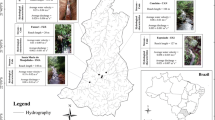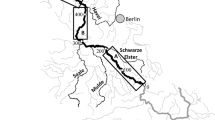Abstract
Reaeration coefficient (k), the rate of oxygen exchange between the atmosphere and water surface, is an important parameter for understanding water quality impairment and stream metabolism. We modified the propane injection method to measure gas exchange coefficients and evaluated its application for small streams. The tracer solution was prepared by solubilizing propane directly in a conservative solute solution, and it was injected as a constant-rate injection, a single slug, or an extended slug. Water samples were taken at four to five sampling stations along the study reach at the tracer concentration peak, and propane and conductivity were measured. The propane exchange rate (k propane) was calculated using the regression method with the propane/conductivity ratio against solute travel time (in hours). The mixed tracer injection method was conducted in four streams, and all k propane measurements (n = 8) were statistically significant (p < 0.05). The short-duration constant rate injection and extended slug injection provided k propane estimates with higher r 2 than the single slug injection. The k 20 measured with propane injection ranged from 5.4 to 40.0 day−1, and they were significantly correlated with empirically estimated k. The mixed tracer injection method with propane could potentially reduce field time, crew demands, and field equipment; thus, it would potentially lower the overall cost of gas exchange coefficient measurements and be an effective method in small, remote streams.



Similar content being viewed by others
References
APHA, AWWA, & WEF. (1998). Standard Methods for the Examination of Water and Wastewater (20th ed.). Washington, DC: American Public Health Association.
Aristegi, L., Izagirre, O., & Elosegi, A. (2009). Comparison of several methods to calculate reaeration in streams, and their effects on estimation of metabolism. Hydrobiologia, 635, 113–124.
Bernot, M. J., Sobota, D. J., Hall, R. O., Mulholland, P. J., et al. (2010). Inter-regional comparison of land-use effects on stream metabolism. Freshwater Biology, 55, 1874–1890.
Bott, T. L. (2006). Primary productivity and community respiration. In F. R. Hauer & G. A. Lamberti (Eds.), Methods in stream ecology (2nd ed., pp. 663–690). New York: Elsevier.
Chapra, S. C., & Di Toro, D. M. (1991). Delta method for estimating primary production, respiration, and reaeration in streams. Journal of Environmental Engineering, 117, 640–655.
Chapra, S. C., & Wilcock, R. J. (2000). Transient storage and gas transfer in lowland stream. Journal of Environmental Engineering, 126, 708–712.
Cirpka, O., Reichert, R., Wannier, O., Stepha, S. R., & Schwarzenbach, R. P. (1993). Gas exchange at river cascade: field experiments and model calculations. Environmental Science and Technology, 27, 2086–2097.
Elmore, H. L., & West, W. F. (1961). Effects of water temperature on stream reaeration. Journal of Sanitary Engineering ASCE, 91, 59–71.
Genereux, D. P., & Hemond, H. F. (1992). Determination of gas exchange rate constants for a small stream on Walker Branch watershed, Tennessee. Water Resources Research, 28, 2365–2374.
Gücker, B., Boëchat, I. G., & Giani, A. (2009). Impacts of agricultural land use on ecosystem structure and whole-stream metabolism of tropical Cerrado streams. Freshwater Biology, 54, 2069–2085.
Hibbs, D. E., Parkhill, K. L., & Gulliver, J. S. (1998). Sulfur hexafluoride gas tracer studies in streams. Journal of Environmental Engineering, 124, 752–760.
Hope, D., Palmer, S. M., Billett, M. F., & Dawson, J. J. C. (2001). Carbon dioxide and methane evasion from a temperate peatland stream. Limnology and Oceanography, 46, 847–857.
Houser, J. N., Mulholland, P. J., & Maloney, K. O. (2005). Catchment disturbance and stream metabolism: patterns in stream respiration and gross primary production along a gradient of upland soil and vegetation disturbance. Journal of the North American Benthological Society, 24, 538–552.
Jones, J. B., & Mulholland, P. J. (1998). Influence of drainage basin topography and elevation on carbon dioxide and methane supersaturation of stream water. Biogeochemistry, 40, 57–72.
Kilpatrick, F. A., Rathburn, R. E., Yotsukura, N., Parker, G. W., & DeLong, L. L. (1989). Determination of stream reaeration coefficients by use of tracers. U.S. Geological Survey Techniques of Water-Resources Investigations, Chapter A18, Book 3 Applications of Hydraulics, 52 pp.
Kosinski, R. J. (1984). A comparison of the accuracy and precision of several open-water oxygen productivity techniques. Hydrobiologia, 119, 139–148.
Liu, C. C. K., & Fok, Y. S. (1983). Stream waste assimilative capacity analysis using reaeration coefficients measured by tracer techniques. Water Resources Bulletin, 19, 439–445.
Marzolf, E. R., Mulholland, P. J., & Steinman, A. D. (1994). Improvements to the diurnal upstream-downstream dissolved oxygen change technique for determining whole-stream metabolism in small streams. Canadian Journal of Fisheries and Aquatic Sciences, 51, 1591–1599.
McBride, G. B. (2002). Calculating stream reaeration coefficients from oxygen profiles. Journal of Environmental Engineering, 128, 384–386.
McCutchan, J. H., Lewis, W. M., & Saunders, J. F. (1998). Uncertainty in the estimation of stream metabolism from open-channel oxygen concentrations. Journal of the North American Benthological Society, 17, 155–164.
McTammany, M. E., Benfield, E. F., & Webster, J. R. (2007). Recovery of stream ecosystem metabolism from historical agriculture. Journal of the North American Benthological Society, 26, 532–545.
Morse, N., Bowden, W. B., Hackman, A., Pruden, C., Steiner, E., & Berger, E. (2007). Using sound pressure to estimate reaeration in streams. Journal of the North American Benthological Society, 26, 28–37.
Mulholland, P. J., Fellows, C. S., Tank, J. L., Grimm, N. B., Webster, J. R., Hamilton, S. K., et al. (2001). Inter-biome comparison of factors controlling stream metabolism. Freshwater Biology, 46, 1503–1517.
Odum, E. P. (1956). Primary production in flowing waters. Limnology and Oceanography, 1, 102–117.
Owens, M., Edwards, R. W., & Gibbs, J. W. (1964). Some reaeration studies in streams. International Journal of Air and Water Pollution, 8, 469–486.
Rathbun, R. E., Stephens, D. W., Schultz, D. J., & Tai, D. Y. (1978). Laboratory studies of gas tracers for reaeration. Journal of the Environmental Engineering Division, 104, 215–229.
Reid, S. E., Mackinnon, P. A., & Elliot, T. (2007). Direct measurements of reaeration rates using noble gas tracers in the River Lagan, Northern Ireland. Water and Environment Journal, 21, 182–191.
Runkel, R. L. (1998). One-dimensional transport with inflow and storage (OTIS): a solute transport model for streams and rivers. US Geological Survey Water-Resources Investigations Report 98-4018, US Geological survey: Denver, Colorado; 73pp. (Available from: http://co.water.usgs.gov/otis, last accessed 12/18/2011).
Tobias, C. R., Böhlke, J. K., Harvey, J. W., & Busenberg, E. (2009). A simple technique for continuous measurement of time-variable gas transfer in surface waters. Limnology and Oceanography: Methods, 7, 185–195.
Tsivoglou, E. C., & Neal, L. A. (1976). Tracer measurement of reaeration: III. Predicting the reaeratin capacity of inland streams. Journal of the Water Pollution Control Federation, 48, 2669–2689.
Tsivoglou, E. C., Cohen, J. B., Shearer, S. D., & Godsil, P. J. (1968). Tracer measurement of stream reaeration. Part II. Field studies. Journal of the Water Pollution Control Federation, 40, 285–305.
Wanninkhof, R., Mulholland, P. J., & Elwood, J. W. (1990). Gas exchanges rates for a first-order stream determined with deliberate and natural tracers. Water Resources Research, 26, 1621–1630.
White, D. S., Johnston, K. L., & Rice, G. T. (2007). The Center for Reservoir Research over its first twenty years with special reference to the long-term monitoring program. Journal of the Kentucky Academy of Science, 68, 2–10.
Wilcock, R. J. (1982). Simple predictive equation for calculating stream reaeration rate coefficients. New Zealand Journal of Science, 25, 53–56.
Wilcock, R. J. (1988). Study of river reaeration at different flow rates. Journal of Environmental Engineering, 114, 91–105.
Young, R. G., & Huryn, A. D. (1999). Effects of land use on stream metabolism and organic mater turnover. Ecological Applications, 9, 1359–1376.
Young, R. G., Townsend, C. R., & Matthaei, C. (2004). Functional indicators of river ecosystem health—an interim guide for use in New Zealand. Cawthron Report Number 870. Nelson, New Zealand: Cawthron Institute.
Acknowledgments
We are grateful to the staff and students at the Hancock Biological Station and Watershed Studies Institute for their assistance in field experiments and chemical analyses. Jane Benson of the Mid-America Remote-sensing Center produced the study site map. Comments from Milt Ward, Ken Fritz, Jake Beaulieu, and an anonymous reviewer helped to improve the earlier version of this manuscript. HJ was supported by a post-doctoral fellowship at the Hancock Biological Station.
Author information
Authors and Affiliations
Corresponding author
Rights and permissions
About this article
Cite this article
Jin, HS., White, D.S., Ramsey, J.B. et al. Mixed Tracer Injection Method to Measure Reaeration Coefficients in Small Streams. Water Air Soil Pollut 223, 5297–5306 (2012). https://doi.org/10.1007/s11270-012-1280-8
Received:
Accepted:
Published:
Issue Date:
DOI: https://doi.org/10.1007/s11270-012-1280-8




